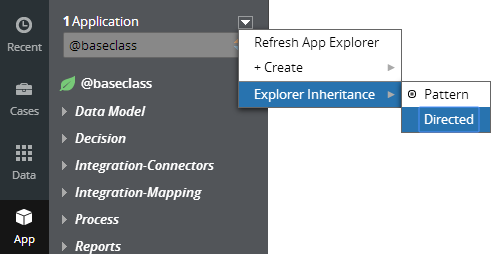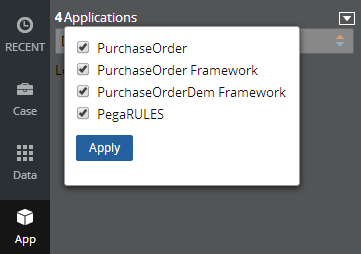Designer Studio
Valid from Pega Version 7.1.3
Numerous usability improvements were made for this release. A group of cosmetic, functional, and performance enhancements were also included.
- Treegrid controls work more quickly in IE9 and IE10.
- On application ruleforms, the 5.4 "Place Properties on Thread Page" checkbox will work in 7.1.
- Message error handling has been improved.
- Log messages have been cleaned up.
- Connectors may now be used in Data Pages.
- Move Rules wizard has been enhanced to work in Version 7.1.
Guardrails compliance score
Valid from Pega Version 7.1.5
The Application Guardrails landing page has been enhanced to help you build more guardrail-compliant applications. Increase transparency and accountability on your projects by responding to the following compliance score metrics:
- A weighted compliance score (0-100) based on warnings, severity, and justification
- A percentage of compliant rules in your application
- Total number of rules in your application
- Total number of rules in your application with warnings (justified and unjustified)
Additional metrics include alert and interaction count trends over the last four weeks.
For more information, see Guardrails compliance score.
Directed inheritance view in Application Explorer
Valid from Pega Version 7.1.5
You can now specify which inheritance model is used to populate classes in the Application Explorer. From the top level menu, use the “Explorer Inheritance” option to choose between:
- Pattern: only display class names whose prefix matches the root node class name.
- Directed: first display classes that explicitly name the root node as the parent class; then display classes with pattern inheritance.

By default, the Application Explorer loads using Pattern inheritance.
Save Application Explorer filter selections
Valid from Pega Version 7.1.5
Application scoping control selections made in the Application Explorer are now persisted between sessions. These preferences are stored in an operator record on an access group level. If you delete (and later re-add) an access group on your operator form, the application scoping control defaults to all layers selected:

External access control DASS
Valid from Pega Version 7.1.5
A new Dynamic Admin System Setting (DASS) controls the Designer Studio's access to external systems, specifically the PDN RSS feed found on the home page.
By default, Pega-Desktop.AllowAccessToExternalSystem is set to TRUE. Update this setting to FALSE to hide the PDN RSS feed and ensure that no RSS fetch is performed.
Use multiple built-on applications to enhance ruleset reuse
Valid from Pega Version 7.2
Applications can now have multiple built-on applications, allowing rules to be reused as a part of a built-on application at run time while being developed independently at design time.
Previously, applications built in Pega 7.1 and earlier versions were assembled in a single linear application stack--one application built on top of another application, and so on. Attempting to reuse rulesets and frameworks across applications resulted in having to splice applications together, creating challenges when attempting to support the use of these custom created applications. Starting in Pega 7.2, applications are built on to other applications by using a hierarchical tree structure, and the Pega 7 Platform automatically converts this tree into a linear application stack.
For more information, see Using multiple built-on applications and the Ruleset behavior at design time section in Application stack hierarchy for multiple built-on applications.
Support for delegating map values, correspondence rules, and circumstances
Valid from Pega Version 7.2
You can now delegate map values and correspondence rules from the menu. In addition, you can delegate circumstanced types of the following supported rules and data types:
- Map values
- Correspondence rules
- Paragraphs
- Decision tables
- Data types
Offline support for mobile applications
Valid from Pega Version 7.2
You can work on assignments and create cases while your mobile device is offline. By enabling offline support for a case type, you can move cases closer to resolution while your application is disconnected from the network.
For more information, see Enabling offline for support for a case type.
Relevant records to define reusable assets
Valid from Pega Version 7.2
Relevant records describe the collection of rules that refine the behavior, presentation, and definition of a case or data type. They are commonly used to designate records from an inherited class as important or reusable in a child class.
Use relevant records to define information displayed in certain Pega 7 Platform application screens and fields. The Pega 7 Platform provides a number of items marked as relevant records, and you can further manage relevant records for your own case and data types.
For more information, see Relevant records.
Current parameter page can now be passed into activities, collections, and data transforms
Valid from Pega Version 7.2
In collection rules, you can now pass the current parameter page into an activity, data transform, or another collection when you call the activity, data transform, or collection from either a primary or a response action instead of setting up parameters before you call one of these types of rules. The Pass current parameter page check box is now supported on the Collection rule form.
For more information, see Rules and methods supported by a collection.

